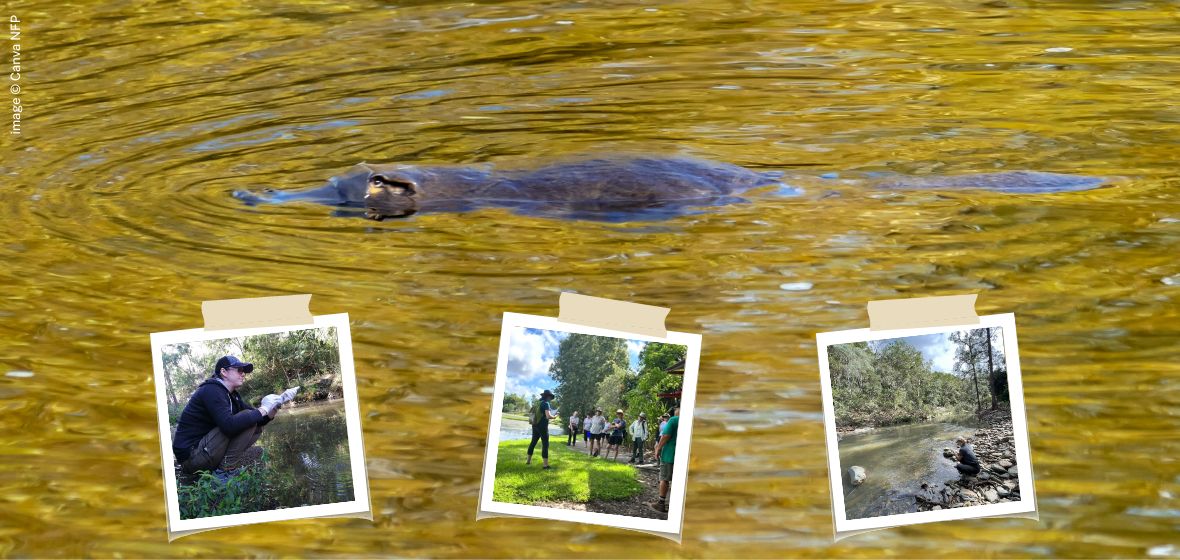
23 May 2023
Wildlife Queensland’s PlatypusWatch has commenced its annual platypus monitoring survey in South East Queensland using the environmental DNA (eDNA) detection method.
This year will be the program’s eighth consecutive year of platypus eDNA monitoring across Greater Brisbane, and it’s shaping up to be a bumper survey with more than 170 sampling sites planned for the three-month survey period.
PlatypusWatch is delighted that the region’s major local governments have committed to funding eDNA surveys in catchments within their areas again.
Platypus (Ornithorhynchus anatinus) are an intriguing species and always generate much interest within the community, and as Queenslanders, we are fortunate to have the species in our local creeks and streams.
This time of the year is often the busiest for monitoring platypus populations as this unique monotreme is more active during the day in winter and early spring. It’s also their breeding season, and because of the colder weather, they need extra food and spend more time searching for it.
Detecting platypus eDNA
Environmental DNA originates from cellular material shed by platypus (via the skin, excrement, etc.) in aquatic environments. As secretive species, like the platypus, are more difficult to detect, eDNA detection provides a non-invasive alternative for aquatic inventory and monitoring programs.
The focus for the 2023 platypus eDNA surveys is to sample over 170 sites to establish an occupancy model for the species here in South East Queensland.
What’s an ‘occupancy model’?
The occupancy model is a statistical framework used to estimate the probability of the presence or absence of a species in a given area. It takes into account imperfect detection and represents both the true occupancy and the detection probability, allowing researchers to estimate and understand patterns of species distribution.
Various factors, such as water quality, chemistry, temperature, flow rate, UV exposure, and water body size, can affect how long platypus DNA fragments remain detectable in water. These factors can differ between sample sites and on different days.
As a result of this variability, water samples taken from a particular location may not contain platypus DNA. Analysing the eDNA samples would indicate the absence of platypus in an area where they could potentially be found.
Using the occupancy model will help to determine whether negative eDNA results indicate the absence of platypus at a specific location or merely the failure to detect it. The model will help provide valuable information and data on whether Queensland platypus populations are in decline, stable or increasing. The team will work closely with EnviroDNA to achieve the project outcomes.
PlatypusWatch is running platypus events around the Greater Brisbane region
PlatypusWatch ecologist, Tamielle Brunt, is leading several platypus-focused events around the Greater Brisbane region during 2023, where communities can learn about this incredible species, their biology, habitat requirements and conservation needs.
A PlatypusWatch ‘Walk & Talk’ was held along Albany Creek in May, where Brunt wandered the creek with locals and talked about a precious pocket of platypuses in the area. These ‘Walk and Talks’ aim to connect local residents with platypus populations in their backyards.
“I’m a big believer in community and their power to connect and protect their natural areas,” said Brunt.
“If they can experience and learn about the ecosystems and species close to their homes, I hope they are then inspired to take action to help protect them.”
Wildlife Queensland sends a big thank you to everyone who attended and the North Brisbane Catchments group for their support and continued conservation efforts in the area.
The Brisbane Airport Community Giving Fund proudly supports these events. Please note that these events are targeted at residents in a particular area. Check the Wildlife Queensland Events Calendar to see if there are any upcoming events near you.
Spotted a platypus?
Please report your platypus sightings here.
